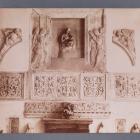The museum boasts over two centuries of uninterrupted activity. In the last two decades of the 18th century a group of open minded academics came together to keep the Lombard capital's artistic and historic heritage from leaving the city, forming various collections that went on to become part of the permanent museums over the course of the 1800s. Giuseppe Bossi, Secretary of the Brera Academy and scholar of Leonardo da Vinci, contributed to the first phase of the founding of the museum with his lucid tenacity.
The artefacts in the museum originate from two institutions: the Museo Patrio di Archeologia, founded by the Italian state in 1862 and the Museo Artistico Municipale (Municipal Museum of Art), established by the municipality of Milan in 1878.
Two 20th century inaugurations
Following the architectural and functional restoration of the Sforza Castle, the two collections were united to become the Museo Archeologico e Artistico (Museum of Archaeology and the Arts), which was opened to the public within the rooms of the Ducal Court on the 10th May 1900. The 12th April 1956 marked a new phase in the exhibition of the defining sculptures and architectural monuments of Lombardy's artistic heritage, from the high Medieval period to the Renaissance.








